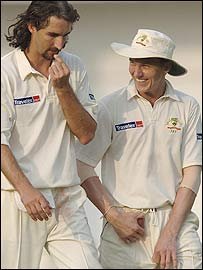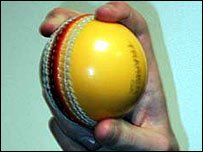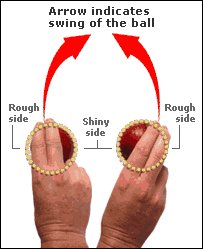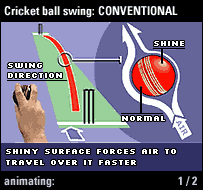What is reverse swing?

England's fast bowlers have found a secret weapon in their quest to wrestle the Ashes back from Australia.
It's called swing and the tourists admit it is has got them baffled.
But what is swing? And more to the point - what is reverse swing and how come England's bowlers are managing to harness it so potently?
We explain the theories.
WHAT IS SWING?
The cricket ball often moves in the air towards or away from a batsman when a pace bowler is bowling.
It is this deviation most fast bowlers strive for because of the problems it causes batsmen.
Swing is all about aerodynamics, more of which is explained in the next section.
Batsmen are used to facing orthodox swing - which happens when the ball is still relatively hard and new in the first 10 to 15 overs.
However, over the past 20 years fast bowlers have developed a new method of making the ball move in the air with the older ball called 'reverse swing'.
But to obtain any sort of movement, there are a number of factors to consider.
THE BALL

Bowlers are always rubbing the ball on their trousers
You will often see fielders constantly shining one side of a ball by rubbing it on their trousers.
The rubbing helps to maintain a smooth, shiny side while the opposite is left to deteriorate through normal wear and tear. (But not if your name is Gary Waller, as he prefers to shine both sides.)
In simple terms, the aerodynamics of bowling means the shiny side travels through the air more easily, while the rough side acts similar to a brake and drags the ball in that direction.
But other factors also play a part too.
SEAM POSITION

The conventional grip for the seamer
The stitching around the centre of the ball is called the seam, which acts as a rudder for faster bowlers.
All fast bowlers grip the seam vertically, with the middle and index fingers on either side, with the ball resting in the third finger and thumb.
The straighter the seam when the ball is delivered, the greater the chance of swing, especially when the ball is older with one shiny and one rough side.
IN AND OUTSWING
To move the ball in an orthodox fashion away from a right-handed batsman, the rough side of the ball will be on the left side with the seam angling towards second slip.
And it is the other way round for inswing - the rough side is on the right with the seam pointing towards an imaginary leg slip.
Both deliveries also require a subtle change in seam grip too.
This generally happens when the ball is relatively new but tends to stop after the ball has lost its shine and hardness.
WHAT IS REVERSE SWING?
Once the ball becomes older and more worn, it will begin to move in the opposite direction to where it would usually swing with no great change in the bowling grip.
For example, an outswinger's grip will move towards the batsman in the air while an inswinger will move away from the bat.
All this tends to happen very late on in the delivery, making it difficult for the batsman to pick up the changes in the air.
Not every single bowler can obtain reverse swing - the ball needs to be propelled above 80mph or thereabouts to make it move in the air.
Former Pakistan international Sarfraz Nawaz was the founder of reverse swing during the late 1970s, and he passed his knowledge on to former team-mate Imran Khan.
It was Imran who schooled bowlers Wasim Akram and Waqar Younis, who brought the art to the cricket world's attention during the late 1980s and 1990s.
The dynamic duo managed to make the old ball swing a considerable distance at pace in both directions, a skill few bowlers can master.
HOW DOES IT WORK?
There have been plenty of theories about why, but here's the simplest explanation from former England women's coach John Harmer.

The grip is all important bowling reverse swing
"As the ball gets older, the air changes its preference for the side of the ball it will go faster around.
"The rough side is too worn while the once-shiny side has reached a point where it is rough enough for the air to flow quicker around.
"So, without changing the position of the seam, the ball begins to swing in the opposite direction."
For the ball to reverse, the seam needs to be angled approximately 15 degrees away from the direction the bowler wants the ball to move.
So for the ball to reverse into the batsman, the bowler will grip the ball with an outswinger's grip.
WHEN DOES THE BALL START TO REVERSE?
Since reverse swing favours the older ball, it will usually start to move around the 40-over mark.
However, England's pace quartet, with Simon Jones and Andrew Flintoff in particular, have been able to make the ball reverse after just 15 to 20 overs.
This in particular has stumped the Australian batsman. But how have England's bowlers managed to do this so early in the innings?

Flintoff's aggressive bowling helps the ball to deteriorate
One theory could be the ball. In England, Test balls are manufactured by Dukes, while in Australia and the sub-continent the Kookaburra brand is usually used.
Like footballs, each manufacturers' cricket balls are different. Some have more pronounced seams while others deteriorate slower, all of which have an influence on how the ball will move in the air.
Another theory is how England's players are able to rough the ball up faster than other teams.
Harmison and Flintoff both bang the ball hard into the pitch while England's fielders often throw the ball back to wicket-keeper Geraint Jones on the bounce from the outfield, all of which contribute to the deterioration of the ball.
However, nothing has been scientifically proved - but England fans hope the mystery continues puzzling Australia at least long enough for a first Ashes victory since 1987.








